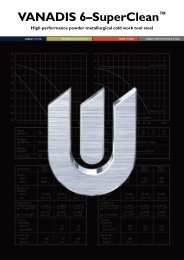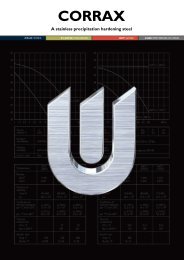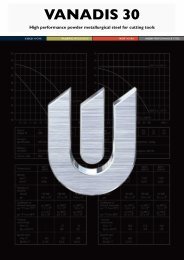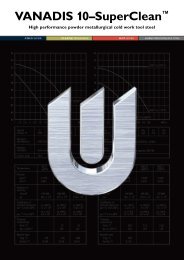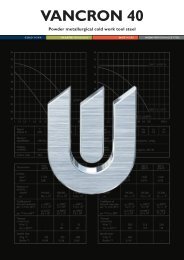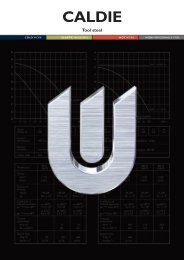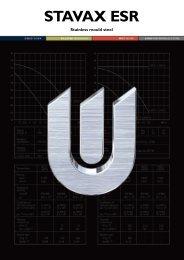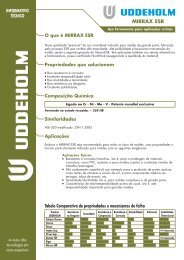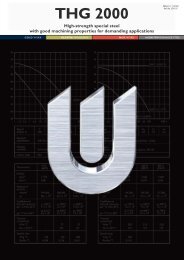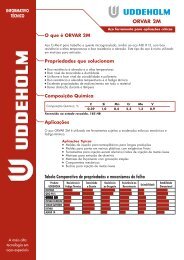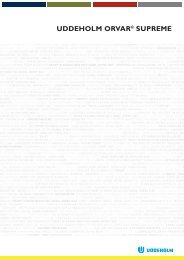UNIMAX - Uddeholm
UNIMAX - Uddeholm
UNIMAX - Uddeholm
You also want an ePaper? Increase the reach of your titles
YUMPU automatically turns print PDFs into web optimized ePapers that Google loves.
<strong>UNIMAX</strong><br />
DIMENSIONAL CHANGES<br />
DURING HARDENING AND TEMPERING<br />
The dimensional changes have been measured after<br />
austenitizing at 1020°C (1870°F)/30 minutes<br />
followed by gas quenching in N 2 at a cooling rate of<br />
1,1°C/second between 800–500°C (1470–930°F) in<br />
a cold chamber vacuum furnace.<br />
Specimen size: 100 x 100 x 100 mm (3,9"x 3,9"x<br />
3,9")<br />
Dimensional changes, %<br />
0,16<br />
0,12<br />
0,08<br />
0,04<br />
1020°C Transverse<br />
0,00<br />
1020°C Short transverse<br />
1020°C Longitudinal<br />
–0,04<br />
500 520 540 560 580 600°C<br />
932 968 1004 1040 1076 1112°F<br />
Tempering temperature (2 x 2h)<br />
Surface treatments<br />
Tool steels may be given a surface treatment in<br />
order to reduce friction and increase wear resistance.<br />
The most commonly used treatments are<br />
nitriding and surface coating with wear resistant<br />
layers produced via PVD or CVD.<br />
The high hardness and toughness together with a<br />
good dimensional stability makes Unimax suitable<br />
as a substrate steel for various surface coatings.<br />
NITRIDING AND NITROCARBURIZING<br />
Nitriding and nitrocarburizing result in a hard<br />
surface layer which is very resistant to wear and<br />
galling.<br />
The surface hardness after nitriding is approximately<br />
1000–1200 HV 0,2kg . The thickness of the layer<br />
should be chosen to suit the application in question.<br />
PVD<br />
Physical vapour deposition, PVD, is a method for<br />
applying wear-resistant surface coating at temperatures<br />
between 200–500°C (390–930°F).<br />
Cutting data<br />
recommendations<br />
The cutting data below are to be considered as<br />
guiding values which must be adapted to existing<br />
local conditions.<br />
Condition: Soft annealed to ~185 HB<br />
TURNING<br />
Turning with<br />
Turning<br />
carbide<br />
with high<br />
Cutting data<br />
speed steel<br />
parameters Rough turning Fine turning Fine turning<br />
Cutting<br />
speed (v c )<br />
m/min 150–200 200–250 15–20<br />
f.p.m. 490–655 655–820 50–65<br />
Feed (f)<br />
mm/r 0,2–0,4 0,05–0,2 0,05–0,3<br />
i.p.r. 0,008–0,016 0,002–0,008 0,002–0,012<br />
Depth<br />
of cut (a p )<br />
mm 2–4 0,5–2 0,5–2<br />
inch 0,08–0,16 0,02–0,08 0,02–0,08<br />
Carbide<br />
designation<br />
ISO P20–P30 P10 –<br />
US C6–C5 C7 –<br />
Coated carbide Coated carbide<br />
or cermet<br />
MILLING<br />
Face- and square shoulder milling<br />
Milling with carbide<br />
Cutting data<br />
parameters Rough milling Fine milling<br />
Cutting speed (v c )<br />
m/min 120–170 170–210<br />
f.p.m. 394–558 558–690<br />
Feed (f z )<br />
mm/tooth 0,2–0,4 0,1–0,2<br />
inch/tooth 0,008–0,016 0,004–0,008<br />
Depth of cut (a p )<br />
mm 2–4 0,5–2<br />
inch 0,08–0,16 0,02–0,08<br />
Carbide designation<br />
ISO P20–P40 P10<br />
US C6–C5 C7<br />
Coated carbide Coated<br />
carbide<br />
or cermet<br />
CVD<br />
Chemical vapour deposition, CVD, is a method for<br />
applying wear-resistant surface coating at a temperature<br />
of around 1000°C (1830°F).<br />
5



